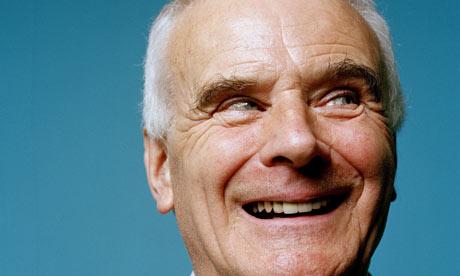Sir Peter Maxwell Davies’ Ninth Symphony, completed in 2012 and heard in London for the first time in this concert, is dedicated to the Queen on her Diamond Jubilee. Those are not words to strike eager anticipation into my heart , though I’m happy to say that being Master of the Queen’s Music doesn’t appear to have dulled the composer’s powers in the way the equivalent title seems to nobble poets. Indeed, the dedication is merely that, and the work is no winsome tribute.
The 25-minute single-movement symphony is modelled, Davies’ programme note explains, on the idea of a church with a central isle and side-chapels of contrasting character. Though continuous, it is divided into two parts, and the most noticeable intrusions into the core modernist sound world of the first half are a series of lumpish military marches, played by a brass sextet position to the side of the orchestra. It invites the comparison to Shostakovich’s Lenigrad symphony, and the composer’s note confirms that war was on his mind: "It presented an opportunity to bear witness, in purely musical terms, to what I can only consider, at the deepest and most heartfelt level, our disastrous interventions in Iraq and Afghanistan."
Delius' Violin Concerto was oddly cold
So if this is not quite Davies’ Fallujah symphony, it is certainly not a light-hearted work. After a slow introduction, the Allegro is richly textured and though hovering around tonal bases, it is thick with dissonance. It is both involving and dramatic, with circling low strings and brass at one point seeming to conjure up aircraft overhead. It gives way to a slow second half, at first more brooding and impenetrable, from which Petrenko coaxed out some violent oceanic swells. Towards the end, the mood lightens to, in Davies’ words, a cautious optimism, the interruptions being reworked snippets of a Haydn quartet. Having recently sat through too much of young fashionable composers overstretching themselves, it was a pleasure to hear an ‘establishment’ figure showing how it’s done.
On to the Delius Violin Concerto, played by its most ardent champion, Tasmin Little. Her playing remains, as always, technically brilliant, and her sense of line and legato faultless, but the piece itself is oddly cold. Its meandering, improvisational character could be described as colouristic, but really watercolouristic would be a more appropriate term for the pallid blues, greens and browns of its landscape. Perhaps it would feel more at home in a less cavernous setting since, straining sometimes to hear the soloist, it was hard to surrender my heart strings.
It is not difficult to see why Shostakovich’s Tenth Symphony is his most performed, certainly at the Proms. It is absolutely gripping, rather despite the constant speculation of where Stalin might fit in, for which the blame lies with Solomon Volkov’s semi-fictionalised accounts of conversations with the composer. The only personality we can be certain is stamped on this work is Shostakovich’s own, sometimes monogrammatically pushing itself to the fore, or even crashing through the texture, others just present in the hectoring, cross-accented motifs.
It is tense music indeed, but Petrenko allowed it to wallow when he could, only to better ratchet up the angst later. It is a warm stringy soup from which the vast first movement rises, and into which it descends with nothing but a lonely piccolo for company. The infernal dance of the second movement and the whirling melodies of the fourth are a big test for an orchestra’s cohesion, and the RLPO played thrillingly as one.
One of the unique values of the Proms is the opportunity to measure up so many different orchestras in the same venue, and on this evening’s showing it would be hard to name a single reason that Liverpudlian concertgoers should feel envious of the capital’s riches.
- Read theartsdesk's 2012 Proms coverage
- See portraits of Proms performers by photographer Chris Christodoulou on theartsdesk's Facebook page














Add comment